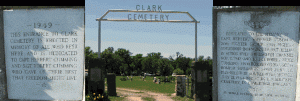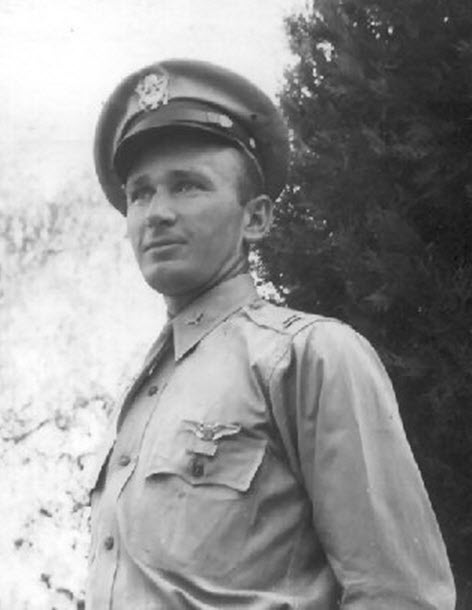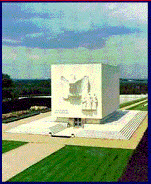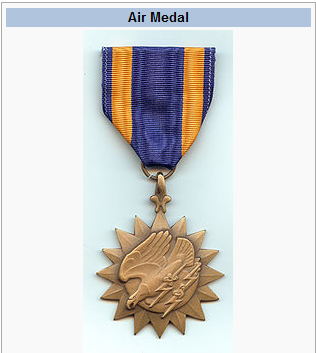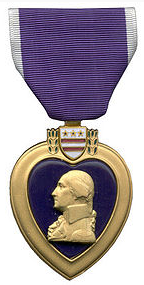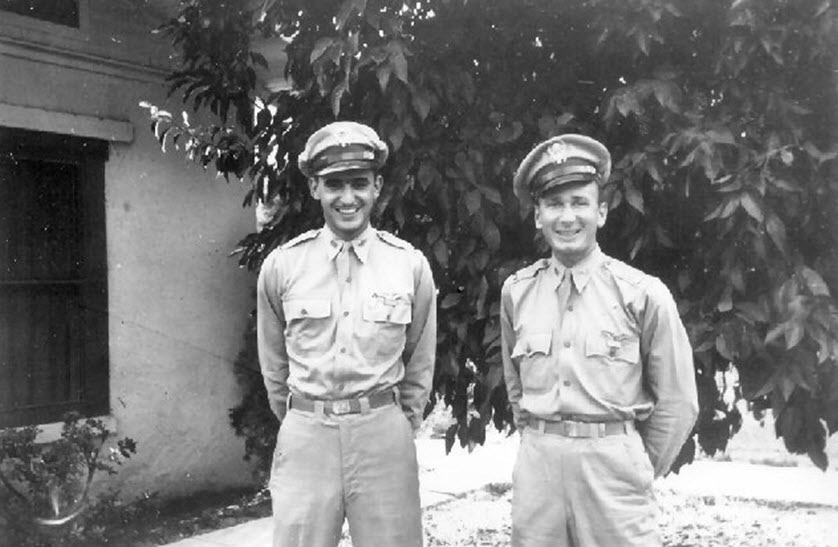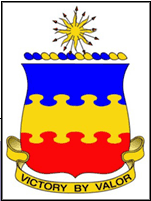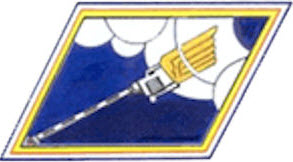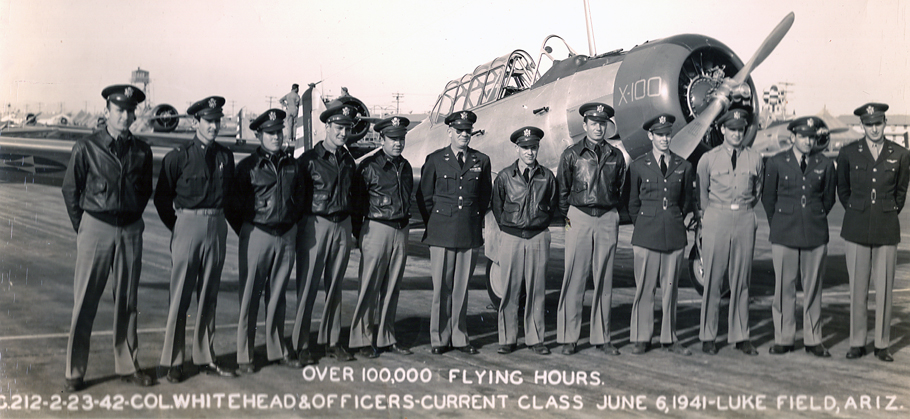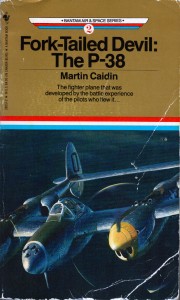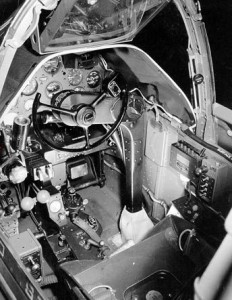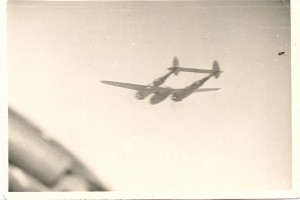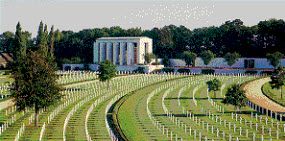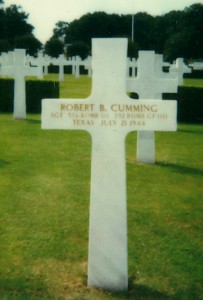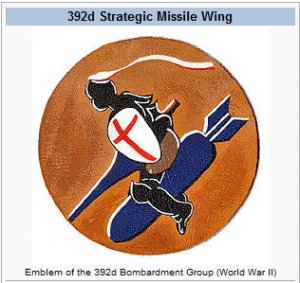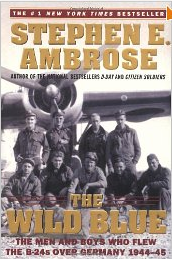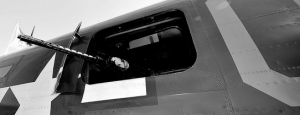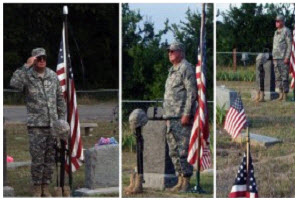Captain Herbert and Sergeant Robert Cumming
November 7, 1943 and July 21, 1944
Clark Cemetery Memorials
The late (deceased 1984) Mrs. S. E. Jessie Margaret (McAnally) Cumming headed a beautification committee for Clark Cemetery. She commissioned rock work to be done on the entrance gate that included memorial stone engravings in honor of her sons, Herbert Winfield and Robert Bruce Cumming who gave their lives, along with countless others, to fight tyranny during World War II. She had memorial headstones placed near her and her husband Samuel Eugene Cumming’s grave site at Clark Cemetery. Mrs. S. E. Cumming lost her husband and two of her boys within the span of just four years. Her husband, Samuel Eugene Cumming, died January 31, 1940. She lost her third son, Richard Alton Cumming in 1961.
Captain Herbert W. Cumming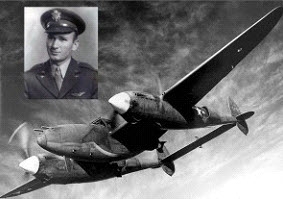
January 19, 1917 to November 7, 1943
Memorial in Belgium
- Capt. Cumming is listed on the “Tablets of the Missing” at Ardennes American Cemetery.
Capt. Herbert W. Cumming’s name is listed on the “Tablets of the Missing” at Ardennes American Cemetery in Neupré (Neuville-en-Condroz), 12 miles southwest of Liège, Belgium. The site of the cemetery was liberated from Nazi control by the U.S. 1st Infantry Division on 8 September 1944. A temporary cemetery was established on the site on 8, February 1945. After the war, the Ardennes site was designated a permanent cemetery, becoming one of fourteen permanent cemeteries for American World War II dead on foreign soil. All temporary cemeteries were disestablished by the U.S. Army, and the bodies of those whose next of kin requested permanent interment overseas were moved to one of the fourteen permanent cemeteries. The facade on the far (north) end, which overlooks the burial area, bears the insignia in mosaic of the major United States units which operated in northwest Europe in World War II. Along the outside of the memorial are the “Tablets of the Missing” — granite slabs on which are inscribed the names of 462 American missing (15 Navy and 447 Army and Army Air Forces) who gave their lives in the service of their country, but whose remains were never recovered or identified.
Capt. Cumming received the Air Medal and Purple Heart. The Air Medal was established by Executive Order 9158, signed by Franklin D. Roosevelt, on 11 May 1942. The Air Medal was awarded retroactive to 8 September 1939. The medal is awarded to any person who, while serving in any capacity in or with the Armed Forces of the United States, shall have distinguished himself/herself by meritorious achievement while participating in aerial flight.
The Purple Heart is a United States military decoration awarded in the name of the President to those who have been wounded or killed while serving on or after April 5, 1917 with the U.S. military. The National
Purple Heart Hall of Honor is located in New Windsor, New York. With its forerunner, the Badge of Military Merit, which took the form of a heart made of purple cloth, the Purple Heart is the oldest award that is still given to members of the U.S. military, the only earlier award being the obsolete Fidelity Medallion.
Capt. Herb Cumming was a Flight Commander and instructor at Luke Field, Arizona before going overseas to Kings Cliffe, England, UK as P-38 Squadron leader — information about the stateside fighter training at Luke Field.
Captain Herbert Cumming’s Mission
On 7th November 1943, the IXth Bomber Command dispatched three forces of approximately 72 B-26s each against airfield targets in German occupied northwestern France. One force was sent against an airfield in the Paris area (Meulan-les-Mureaux) and was supported by four squadrons of P-38s and three squadrons of P-47s of this Command. Capt. Cumming’s squadron, of the 20th Fighter Group of the (all of them P-38s), 79th Fighter Squadron, provided Close Escort at bomber level for the mission. On returning, Capt. Cumming’s P-38 was hit by three FW-190s. Witnesses 1st Lt. Robert J. Meyer, 1st Lt. Merle B. Nichols, and Major Richard L. Ott concurred in that they saw the left propeller feathered, smoke intermittently coming from the right engine. None saw Capt. Cumming strike or enter the water but saw his parachute down and blown along the surface of the water. All said the wind was strong and the water was rough. 1st Lt. Nichols said he saw Capt. Cumming bail out and clear the plane and the chute open but did not see Capt. Cumming strike the water or in the chute on the surface of the water. Major Richard L. Ott (0-41633) who filed an affidavit attached to the Missing Air Crew Report (MACR), circled for some time until his gas got low and had to leave. The P-38 had distinctive twin booms and a single, central nacelle “tub” containing the cockpit and armament. Named “Der Gabelschwanz Tuefel” or in English: “fork-tailed devil” by the Luftwaffe. Capt. Cumming bailed out of this type of airplane over the English Channel.
The report positioned the bailout at about 15 miles off the French coast south of Beachy head near Pointe d’Ailly and Dieppe. The report was filed by Major M. W. Hubble, Assistant Adjutant General. Wingman 1st Lt. Meyer said in his report, filed 9, November, 1943, “I was flying on Captain Cumming’s Wing on an escort mission made on the morning of 7 November 1943. About five or ten minutes before we got to the target, three enemy fighters jumped us and fired from a 90 degree deflection. Immediately following, Captain Cumming’s left engine began to smoke.
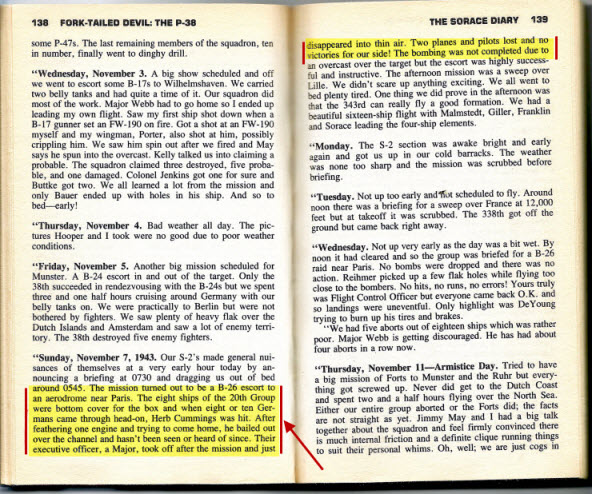
In this diary entry dated Sunday, November 7, 1943, the writer mentions Herb and Major Wilkins who went to search for him but was lost.
He continued on his course. A few minutes after, we started from the Target home, he suddenly began to lose altitude rapidly, leaving the formation and apparently started directly for home by himself. He went down to about 6,000 feet, I followed him down and on reaching that level, noticed that his left propeller was feathered and that smoke was coming from his right engine intermittently. I flew along with him until I was called on radio and told enemy aircraft were near my position – which was up sun from Captain Cumming. I promptly climbed back up to the formation and I next noticed that Captain Cumming was directly under the bombers. I again joined him. His situation did not seem to have changed. At the time, we were over water. Another plane joined me in weaving about over him.
Almost immediately, he [Capt. Cumming] bailed out at an altitude of 3700 feet, cleared the plane, and his chute opened. I circled and called the Air-Sea-Rescue Service on B Channel for a fix. They answered and asked how long I could stay. To this I replied that I was low on gas and could not stay long. Lt. Nichols stayed on and gave them a fix. I did not see Captain Cumming strike the water and I did not see him after the chute was down and being blown along the surface. I circled twice after the chute was at water level but saw no further signs of Captain Cumming,” Major Wilkins, who was supposed to lead the mission, but couldn’t get his plane, later took off to search for Herbert but was himself lost. Herbert is briefly mentioned in the book by Martin Caidin: The forked Tail Devil – The P-38, published by Bantam Books. The mention is in “The Sorace Diary” (p. 138).
Sergeant Robert B. Cumming
June 10, 1923 to July 21, 1944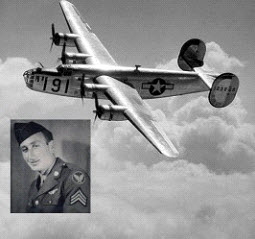
Burial in Cambridge
Sgt. Robert B. Cumming is buried at Cambridge American Cemetery and Memorial near Cambridge UK, in Grave E-2-34. The Cambridge American Cemetery and Memorial site in England, 30.5 acres in total, was donated by the University of Cambridge. It lies on a slope with the west and south sides framed by woodland. The cemetery contains the remains of 3,812 of our military dead; 5,127 names are recorded on the Tablets of the Missing. Rosettes mark the names of those since recovered and identified. Most died in the Battle of the Atlantic or in the strategic air bombardment of northwest Europe. His was awarded the Purple Heart.
Sergeant Robert Cumming’s Mission
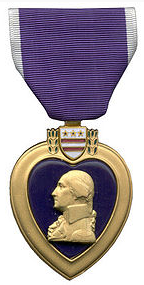 Sgt. Cumming was the left waist gunner on 1st Lt Kenneth A. Smith’s crew in the 576th. Their aircraft was a B-24J Model #42-50650, Call Letter “E,” no nickname of record. The 392nd encountered fierce enemy fighter opposition on this mission. According to the 576th Squadron Diary, Lt Smith came back across
Sgt. Cumming was the left waist gunner on 1st Lt Kenneth A. Smith’s crew in the 576th. Their aircraft was a B-24J Model #42-50650, Call Letter “E,” no nickname of record. The 392nd encountered fierce enemy fighter opposition on this mission. According to the 576th Squadron Diary, Lt Smith came back across
Germany alone flying at altitude within range of light, medium, and heavy flak. When he finally landed at an emergency field in England, he had 65 flak holes in his plane. Sgt. Cumming was killed, right waist gunner Sgt. Norman G. Rose lost his leg while getting a ME-109, and tail gunner Sgt. Ronald E. Young was suffering from severe shock. The plane was escorted all the way home by Capt. Thomas J. McGeever (359th Fighter Group, 369th Fighter Squadron) in a P-51D pursuit plane who may have been the difference between their getting home or going down. Capt. McGeever on one occasion went down to the deck in an attempt to draw some of the flak away from the faltering ship, and on the whole trip out, he was there to encourage the crew and help them through the many rough spots. He crash-landed at RAF Manston, most likely due to fuel shortage. McGeever later was killed in action on 21 November 1944. Sgt. Cumming received the Purple Heart.
A press release in the 392nd Group History Folder in the National Archives gives these additional details: “From his waist gun position, Staff Sergeant Norman G. Rose of Van Wert, Ohio fired almost incessantly at ME-109’s attempting to break up an attack by the Libs on Oberphaffenhofen. Knocking one down, he saw the others peel away as flak guns opened up. Shrapnel ripped through the fuselage, mortally wounding the other waist gunner [Sgt. Cumming]. Sergeant Rose, kneeling over the dying gunner, was himself wounded. In a scream his crew still hears, the Sergeant said, “Oh my God, the sons-of-bitches have cut off my leg.” But through the shock and semi-stupor induced by his wound, the Sergeant noted more danger to his crew. The bomber was on fire. There was nothing within reach to put out the fire except the body of his old friend and crewman [Sgt. Robert Cumming]. Nerving himself, Sergeant Rose rolled the dead gunner’s body over the spot where the smoke was thickest. The fire died; the crew and aircraft were saved.”
For Historic Perspective
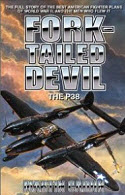
Current hardback cover reprint of Martin Caidin’s book, The Forked Tail Devil The P-38 on Amazon.com.
View a video of a restored P-38 with facts about the P-38 and flight demonstration video with host and aviation author, Jeffrey Ethel. Jeffrey Ethell (1947–1997) was an American aviation author and pilot who wrote extensively on aviation and military matters. He was killed on June 6, 1997, when the restored P-38 Lightning he was flying crashed at Tillamook, Oregon, while preparing for an airshow to honor his father, one of the top P-38 aces of WWII. Starting at a remarkably young age, Ethell, published an extensive series of technical studies of WWII-era aircraft and eventually authored 60 books and over 1,000 magazine articles covering all aspects of aviation. He soloed at 18 and logged over 4,800 hours in over 210 different types of aircraft, including most of the various warbirds of the allied and Axis sides from WWII.
A Modern Day Memorial in 2012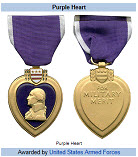
Captain Herbert Winfield Cumming
November 7, 1943
Sergeant Robert Bruce Cumming
July 21, 1944
Final Salute on Memorial Day May 28, 2012
James Shannon Coffee, Specialist, and active member of the Texas State Guard, 1st Battalion, 4th Regiment. Weatherford, Texas, performed the Texas State Guard “Final Salute Ceremony” in honor of Captain Herbert Winfield Cumming and Sergeant Robert Bruce Cumming who were killed in action during World War II, Herbert on November 7, 1943 and Bob on July 21, 1944. Specialist Coffee stood at attention at the Soldier’s Cross erected in front of the memorial headstones for Herbert and Bob. At sunset taps was played as Spc. Coffee saluted Herbert, Bob and all our fallen heroes were killed in action — those associated with the families in Clark Cemetery and all such veterans of all wars.
Mission Accomplished
This “Final Salute” mission was completed on Memorial Day, May 28th 2012 by The Texas State Guard (TXSG). The Texas State Guard is one of the three branches of the Texas Military Forces (TXMF), reporting to The Texas Adjutant General located at Texas Military Forces HQ, Camp Mabry (Austin), Texas. The Commander in Chief of the Texas Military Forces is the Governor of Texas. The other two branches are the Texas Army National Guard (TXARNG) and the Texas Air National Guard (TXANG). Spc. Coffee’s sister, Rebecca Knox, is married to Danny Knox, son of Lucille Clark who is buried in Clark Cemetery. We thank Spc. Coffee for this wonderful tribute in the performance of his duty.

